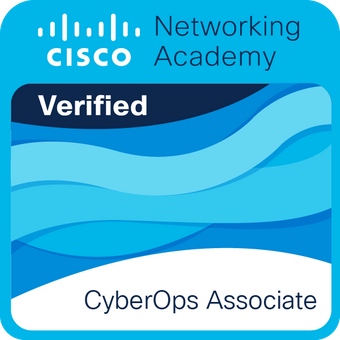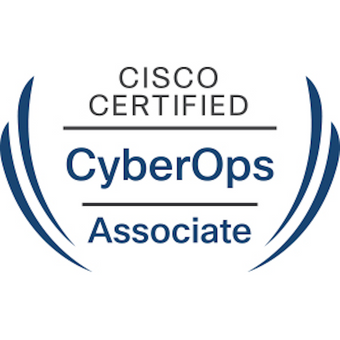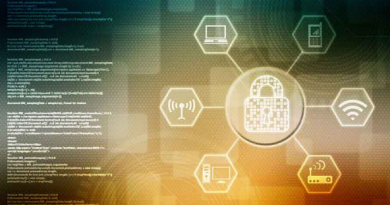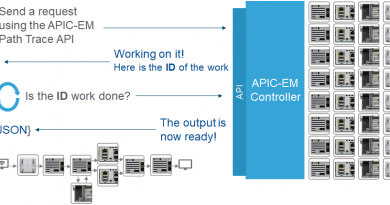Netacad: CCNA Cybersecurity Operations (CBROPS)
Общие сведения
Раскрытие киберпреступлений, борьба с кибершпионажем и другими сетевыми угрозами — лишь некоторые из захватывающих задач специалиста по кибербезопасности в любой отрасли. Изучив этот курс, вы получите цифровой бэдж Сетевой академии. Этот курс также входит в программу подготовки к сертификации Cisco Certified CyberOps Associate и посвящен таким темам, как мониторинг, обнаружение и реагирование на угрозы кибербезопасности в соответствии с NIST Cybersecurity Framework. Вы получите представление о принципах обеспечения безопасности, мониторинге безопасности, анализе на уровне хоста, анализе вторжений в сеть, о политиках и процедурах безопасности. Курс также соответствует программе NICE Cybersecurity Workforce Framework по поддержанию согласованной среды взаимодействия, обучения и повышения квалификации специалистов в сфере кибербезопасности.
Преимущества
Получите знания и навыки, необходимые в этой быстро развивающейся области. Так вы сможете добиться успеха в сфере управления безопасностью, включая такие интересные должности, как специалист по поиску и изучению угроз и специалист по реагированию на инциденты. Однако важнее всего то, что вы сможете помочь сделать этот мир безопаснее.
Учебная программа

Материалы курсы на английском языке. Состав курса:
Module 1. The Danger
1.0 Introduction
1.1 War Stories
1.2 Threat Actors
1.3 Threat Impact
1.4 The Danger Summary
Module 2. Fighters in the War Against Cybercrime
2.0 Introduction
2.1 The Modern Security Operations Center
2.2 Becoming a Defender
2.3 Fighters in the War Against Cybercrime Summary
Module 3. The Windows Operating System
3.0 Introduction
3.1 Windows History
3.2 Windows Architecture and Operations
3.3 Windows Configuration and Monitoring
3.4 Windows Security
3.5 The Windows Operating System Summary
Module 4. Linux Overview
4.0 Introduction
4.1 Linux Basics
4.2 Working in the Linux Shell
4.3 Linux Servers and Clients
4.4 Basic Server Administration
4.5 The Linux File System
4.6 Working with the Linux GUI
4.7 Working on a Linux Host
4.8 Linux Basics Summary
Module 5. Network Protocols
5.0 Introduction
5.1 Network Communication Process
5.2 Communication Protocols
5.3 Data Encapsulation
5.4 Network Protocols Summary
Module 6. Ethernet and Internet Protocol (IP)
6.0 Introduction
6.1 Ethernet
6.2 IPv4
6.3 IP Addressing Basics
6.4 Types of IPv4 Addresses
6.5 The Default Gateway
6.6 IPv6 Prefix Length
6.7 Ethernet and IP Protocol Summary
Module 7. Principles of Network Security
7.0 Introduction
7.1 ICMP
7.2 Ping and Traceroute Utilities
7.3 Connectivity Verification Summary
Module 8. Address Resolution Protocol
8.0 Introduction
8.1 MAC and IP
8.2 ARP
8.3 ARP Issues
8.4 Address Resolution Protocol Summary
Module 9. The Transport Layer
9.0 Introduction
9.1 Transport Layer Characteristics
9.2 Transport Layer Session Establishment
9.3 Transport Layer Reliability
9.4 The Transport Layer Summary
Module 10. Network Services
10.0 Introduction
10.1 DHCP
10.2 DNS
10.3 NAT
10.4 File Transfer and Sharing Services
10.5 Email
10.6 HTTP
10.7 Network Services Summary
Module 11. Network Communication Devices
11.0 Introduction
11.1 Network Devices
11.2 Wireless Communications
11.3 Network Communication Devices Summary
Module 12. Network Security Infrastructure
12.0 Introduction
12.1 Network Topologies
12.2 Security Devices
12.3 Security Services
12.4 Network Security Infrastructure Summary
Module 13. Attackers and Their Tools
13.0 Introduction
13.1 Who is Attacking Our Network?
13.2 Threat Actor Tools
13.3 Attackers and Their Tools Summary
Module 14. Common Threats and Attacks
14.0 Introduction
14.1 Malware
14.2 Common Network Attacks – Reconnaissance, Access, and Social Engineering
14.3 Network Attacks – Denial of Service, Buffer Overflows, and Evasion
14.4 Common Threats and Attacks Summary
Module 15. Observing Network Operation
15.0 Introduction
15.1 Introduction to Network Monitoring
15.2 Introduction to Network Monitoring Tools
15.3 Network Monitoring and Tools Summary
Module 16. Attacking the Foundation
16.0 Introduction
16.1 IP PDU Details
16.2 IP Vulnerabilities
16.3 TCP and UDP Vulnerabilities
16.4 Attacking the Foundation Summary
Module 17. Attacking What We Do
17.0 Introduction
17.1 IP Services
17.2 Enterprise Services
17.3 Attacking What We Do Summary
Module 18. Understanding Defense
18.0 Introduction
18.1 Defense-in-Depth
18.2 Security Policies, Regulations, and Standards
18.3 Understanding Defense Summary
Module 19. Access Control
19.0 Introduction
19.1 Access Control Concepts
19.2 AAA usage and operation
19.3 Access Control Summary
Module 20. Threat Intelligence
20.0 Introduction
20.1 Information Sources
20.2 Threat Intelligence Services
20.3 Threat Intelligence Summary
Module 21. Cryptography
21.0 Introduction
21.1 Integrity and Authenticity
21.2 Confidentiality
21.3 Public Key Cryptography
21.4 Authorities and the PKI Trust System
21.5 Applications and Impacts of Cryptography
21.6 Cryptography Summary
Module 22. Endpoint Protection
22.0 Introduction
22.1 Antimalware Protection
22.2 Host-based Intrusion Prevention
22.3 Application Security
22.4 Endpoint Protection Summary
Module 23. Endpoint Vulnerability Assessment
23.0 Introduction
23.1 Network and Server Profiling
23.2 Common Vulnerability Scoring System (CVSS)
23.3 Secure Device Management
23.4 Information Security Management Systems
23.5 Endpoint Vulnerability Assessment Summary
Module 24. Technologies and Protocols
24.0 Introduction
24.1 Monitoring Common Protocols
24.2 Security Technologies
24.3 Technologies and Protocols Summary
Module 25. Network Security Data
25.0 Introduction
25.1 Types of Security Data
25.2 End Device Logs
25.3 Network Logs
25.4 Network Security Data Summary
Module 26. Evaluating Alerts
26.0 Introduction
26.1 Source of Alerts
26.2 Overview of Alert Evaluation
26.3 Evaluating Alerts Summary
Module 27. Working with Network Security Data
27.0 Introduction
27.1 A Common Data Platform
27.2 Investigating Network Data
27.3 Enhancing the Work of the Cybersecurity Analyst
27.4 Working with Network Security Data Summary
Module 28. Digital Forensics and Incident Analysis and Response
28.0 Introduction
28.1 Evidence Handling and Attack Attribution
28.2 The Cyber Kill Chain
28.3 The Diamond Model of Intrusion Analysis
28.4 Incident Response
28.5 Digital Forensics and Incident Analysis and Response Summary
28.6 Prepare for Your Exam and Launch Your Career!
Разработчик материалов курса
Целевая аудитория
Учащиеся вузов или ссузов, лица окончившие вуз или ссуз, инженерных специальностей или со специализаций в компьютерных сетях, имеющие базовую компьютерную грамотность и опыт использования компьютерных приложений. Рекомендуемая подготовка: Netacad: Cybersecurity Essentials (CSE)
Сертификация
Данный курс готовит к сертификации сертификации 200-201 CBROPS Cisco Certified CyberOps Associate.
Вид:
повышении квалификации (141 ак. часа), профессиональная переподготовка (161 ак. часа).
Форма обучения:
очное или очное обучение с применением дистанционных технологий.
Примерное расписание
Длительность обучения: 2 семестра.
Занятия проводятся два раза в неделю с 18.00 до 21.00 с 1 сентября до 1 мая. Точное время занятий и их количество устанавливается на первом занятии.
Стоимость обучения
| Помощь при самостоятельном обучении для студентов МЭИ. | 0 руб. | |
| Обучение в группе под руководством инструктора (от 15 человек) | 14 000 руб. за семестр |
|
| Обучение по сокращенной программе в группе под руководством инструктора (от 15 человек) | 15 400 руб. за семестр | |
| Обучение по расширенной программе в группе под руководством инструктора (от 10 человек) | 18 620 руб. за семестр | |
| Профессиональная переподготовка в группе под руководством инструктора (от 10 человек) | 20 500 руб. за семестр |
Запись на CBROPS:



